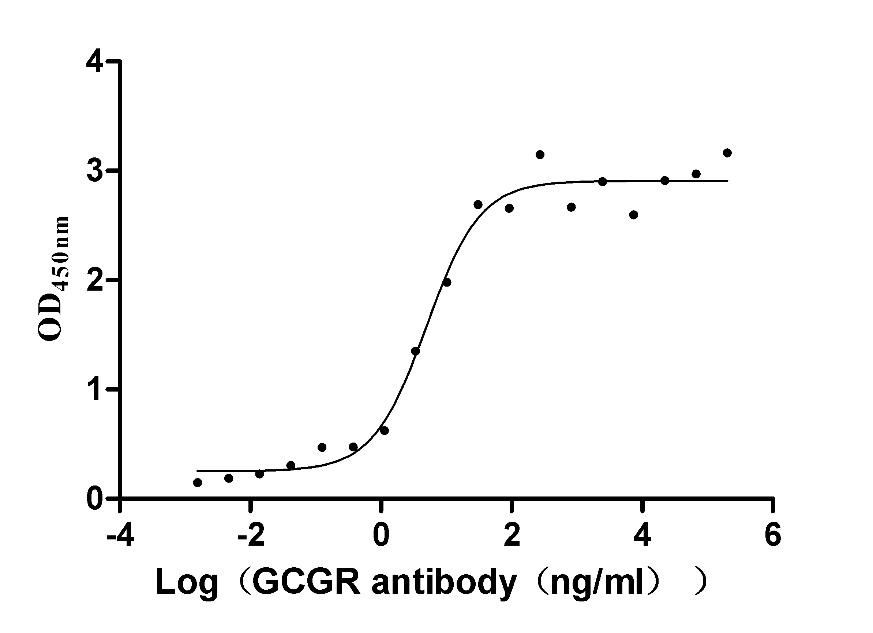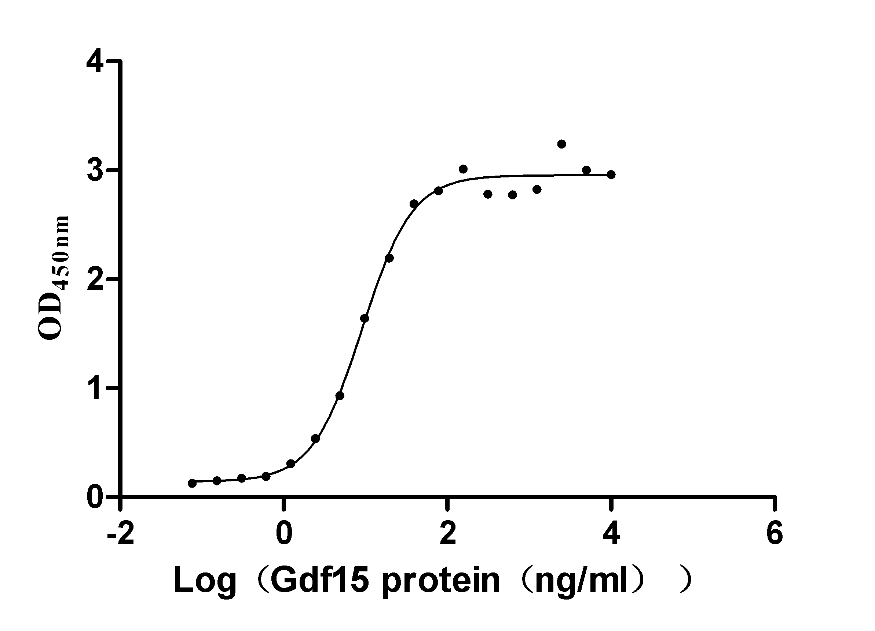Recombinant Mouse Prolactin receptor (Prlr), partial
-
中文名称:小鼠Prlr重组蛋白
-
货号:CSB-YP018727MO
-
规格:
-
来源:Yeast
-
其他:
-
中文名称:小鼠Prlr重组蛋白
-
货号:CSB-EP018727MO
-
规格:
-
来源:E.coli
-
其他:
-
中文名称:小鼠Prlr重组蛋白
-
货号:CSB-EP018727MO-B
-
规格:
-
来源:E.coli
-
共轭:Avi-tag Biotinylated
E. coli biotin ligase (BirA) is highly specific in covalently attaching biotin to the 15 amino acid AviTag peptide. This recombinant protein was biotinylated in vivo by AviTag-BirA technology, which method is BriA catalyzes amide linkage between the biotin and the specific lysine of the AviTag.
-
其他:
-
中文名称:小鼠Prlr重组蛋白
-
货号:CSB-BP018727MO
-
规格:
-
来源:Baculovirus
-
其他:
产品详情
-
纯度:>85% (SDS-PAGE)
-
基因名:
-
Uniprot No.:
-
别名:Prlr; Prolactin receptor; PRL-R
-
种属:Mus musculus (Mouse)
-
蛋白长度:Partial
-
蛋白标签:Tag type will be determined during the manufacturing process.
The tag type will be determined during production process. If you have specified tag type, please tell us and we will develop the specified tag preferentially. -
产品提供形式:Lyophilized powder
Note: We will preferentially ship the format that we have in stock, however, if you have any special requirement for the format, please remark your requirement when placing the order, we will prepare according to your demand. -
复溶:We recommend that this vial be briefly centrifuged prior to opening to bring the contents to the bottom. Please reconstitute protein in deionized sterile water to a concentration of 0.1-1.0 mg/mL.We recommend to add 5-50% of glycerol (final concentration) and aliquot for long-term storage at -20℃/-80℃. Our default final concentration of glycerol is 50%. Customers could use it as reference.
-
储存条件:Store at -20°C/-80°C upon receipt, aliquoting is necessary for mutiple use. Avoid repeated freeze-thaw cycles.
-
保质期:The shelf life is related to many factors, storage state, buffer ingredients, storage temperature and the stability of the protein itself.
Generally, the shelf life of liquid form is 6 months at -20°C/-80°C. The shelf life of lyophilized form is 12 months at -20°C/-80°C. -
货期:Delivery time may differ from different purchasing way or location, please kindly consult your local distributors for specific delivery time.Note: All of our proteins are default shipped with normal blue ice packs, if you request to ship with dry ice, please communicate with us in advance and extra fees will be charged.
-
注意事项:Repeated freezing and thawing is not recommended. Store working aliquots at 4°C for up to one week.
-
Datasheet :Please contact us to get it.
相关产品
靶点详情
-
功能:This is a receptor for the anterior pituitary hormone prolactin.
-
基因功能参考文献:
- Study shows prolactin receptors in Rip-cre cells, but not in AgRP neurones, are involved in energy homeostasis. Results indicate that Rip-Cre neurones in the arcuate nucleus are responsive to prolactin and may play a role in the orexigenic effects of prolactin, whereas prolactin does not directly affect Agrp neurones. PMID: 28378505
- The estrogen-responsive pituitary hormone prolactin (PRL), through specific PRL receptor (PRLR), down-regulates hepatic triglyceride (TG) accumulation. PMID: 29524401
- Truncating mutations of Prlr promote tumor growth in a model of human ERalpha+ breast cancer. PMID: 27681435
- This study demonstrated that there are at least two functional subpopulations of dopamine neurons in the arcuate nucleus, with approximately 50% of these neurons expressing GABA. PMID: 27581458
- Of the four placenta-specific, Prl-related hormones that have been shown to interact with the Prlr, their gene expression localizes to different endocrine cell types PMID: 26269505
- Prolactin receptor was upregulated in proximal kidney tubule cells of mice with cardiac disease. PMID: 23712540
- This study showed in knockout mice showed no effect of PRL and PRL-R gene ablation on heat and cold hyperalgesia in male mice, while heat hyperlgesia were reduced 3-72 h post-surgery in female PRL and PRL-R knockout mice PMID: 23994182
- The in utero environment of the Prlr(+/-) mother confers long-term changes in the pancreatic islets of her offspring such that when the offspring themselves became pregnant, they cannot adapt to the increased insulin demands of their own pregnancy. PMID: 23247113
- results provide direct genetic evidence that PRLR affects energy balance and metabolic adaptation in rodents via effects on brown adipose tissue differentiation and function PMID: 22637534
- Germline knockout of prolactin or its receptor has failed to reveal a key role for prolactin signaling in mouse prostate physiology. PMID: 21971318
- Data suggest that PRL stimulates the Prlr gene expression through the transcriptional activation of mE1(4) first exon, leading to increases in the long- and short-form variants of Prlr mRNA in the murine choroid plexus. PMID: 22294444
- deactivation of MAPK by PRL/PRL-RS contributes to the severe ovarian defect in PRLR(-/-)RS mice and demonstrate the novel association of PRL-RS with DUPD1 and a role for this phosphatase in MAPK deactivation PMID: 21199871
- Suggest that replacement of estrogen and progestin may not increase the mRNA of endometrial PRL receptor in metoclopromide-induced hyperprolactinemia in rats after castration. PMID: 19304288
- Results provide a detailed mapping of the prolactin-responsive neurons in the female mouse forebrain by describing the distribution of prolactin receptor mRNA. PMID: 19882722
- Pancreatic islets of PRLR-deficient mice were smaller, insulin mRNA levels were lower, glucose levels after an ip glucose load were higher PMID: 11897695
- developmental defect of PrlR(-/-) mammary epithelium is rescued by an exogenously expressed chimeric receptor (prl-EpoR) containing the PrlR extracellular domain joined to the EpoR transmembrane and intracellular domains PMID: 12381781
- results suggest that growth hormone can improve mammary development in prolactin receptor(+/-) mice, but that it fails to enhance metabolic activity PMID: 12399427
- data suggest that CCAAT enhancer binding protein-beta is a master regulator of mammary epithelial cell fate and correct spatial pattern of progesterone receptor and prolactin receptor expression is critical for hormone-regulated cell proliferati PMID: 12456789
- PR-1, the short form of the PRLR, can improve mammary development in PRLR+/- mice. This effect is probably caused by accelerated proliferation and an activation of the PRLR signaling cascade. PMID: 12624115
- This protein and its substrates, expressed in murine hair follicle epithelium, show hair cycle-dependent expression, and induce catagen. PMID: 12707045
- function of the SPRLR and a local and targeted effect of PRL on the mammary gland that are essential for its function, but not for its development. PMID: 12746331
- results demonstrate that prostaglandin F2alpha inhibits the expression of the prolactin receptor PMID: 12865306
- the absence of prolactin receptor signaling is not detrimental to male testicular function and to fertility in the mouse. PMID: 12933648
- the expression of a constitutively active PRL-R by transgenesis induces a premature and abnormal mammary development and impairs terminal differentiation and milk production at the end of pregnancy. PMID: 14613905
- These findings suggest a complex tissue-specific regulation of prolactin receptor expression in the context of the acute-phase response PMID: 15186999
- different isoforms of prolactin receptors may be present in the various stages of mouse preimplantation embryo and may play an important role in the control of its growth and development PMID: 15820039
- Cathepsin D secreted from various tissues is able to process PRL into 16K PRL outside the cell. PMID: 16959874
- Report is the first in vivo demonstration that the action of pregnancy hormones, acting through Prlr, is required for normal maternal glucose tolerance during pregnancy by increasing beta-cell mass. PMID: 19036882
- Prolactin independent rescue of mouse corpus luteum life span. PMID: 19531635
显示更多
收起更多
-
亚细胞定位:Membrane; Single-pass type I membrane protein.
-
蛋白家族:Type I cytokine receptor family, Type 1 subfamily
-
数据库链接:
KEGG: mmu:19116
STRING: 10090.ENSMUSP00000122219
UniGene: Mm.10516
Most popular with customers
-
Recombinant Human Tumor necrosis factor ligand superfamily member 9 (TNFSF9), partial (Active)
Express system: Mammalian cell
Species: Homo sapiens (Human)
-
Recombinant Human Glucagon receptor (GCGR), partial (Active)
Express system: Mammalian cell
Species: Homo sapiens (Human)
-
Recombinant Mouse GDNF family receptor alpha-like (Gfral), partial (Active)
Express system: Mammalian cell
Species: Mus musculus (Mouse)
-
Recombinant Macaca fascicularis CUB domain containing protein 1 (CDCP1), partial (Active)
Express system: Mammalian cell
Species: Macaca fascicularis (Crab-eating macaque) (Cynomolgus monkey)
-
Recombinant Human Serotransferrin(TF) (Active)
Express system: Mammalian cell
Species: Homo sapiens (Human)
-
Recombinant Human Dipeptidase 3(DPEP3), partial (Active)
Express system: Mammalian cell
Species: Homo sapiens (Human)
-
Recombinant Macaca fascicularis Dipeptidase 3(DPEP3) (Active)
Express system: Mammalian cell
Species: Macaca fascicularis (Crab-eating macaque) (Cynomolgus monkey)
-
Recombinant Human C-C chemokine receptor type 5 (CCR5)-VLPs (Active)
Express system: Mammalian cell
Species: Homo sapiens (Human)




















